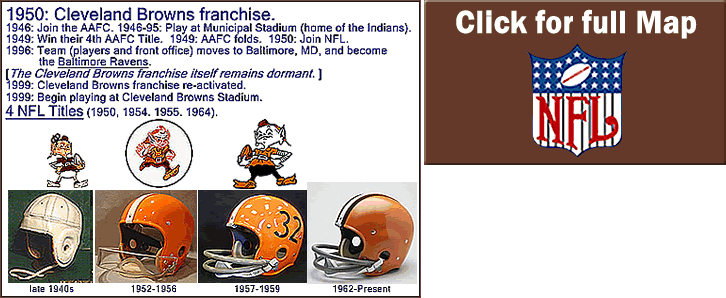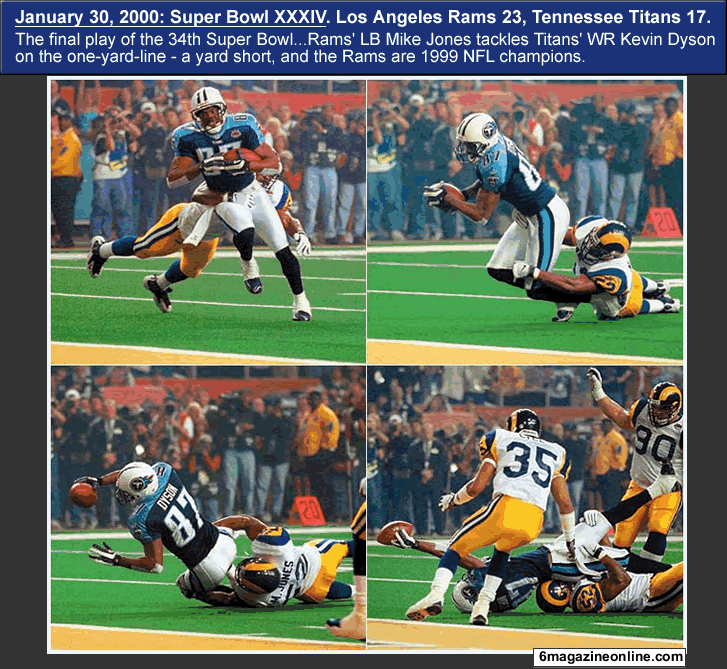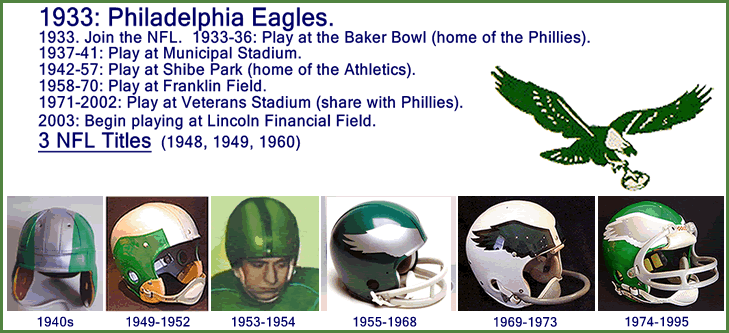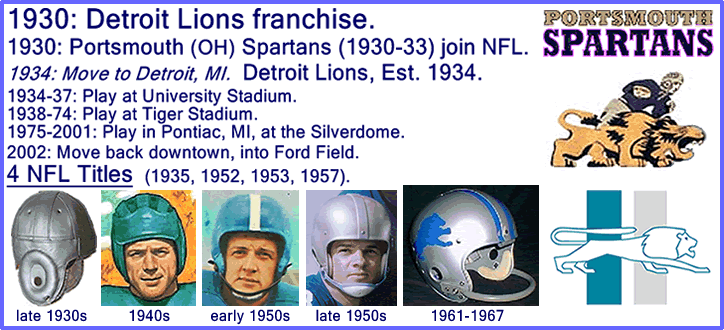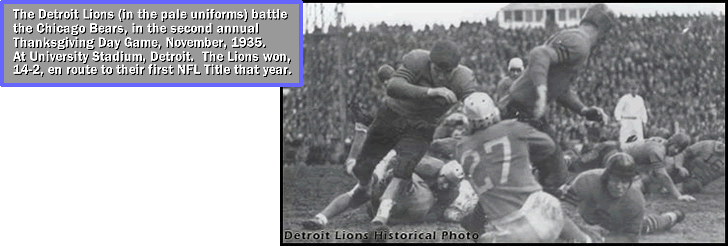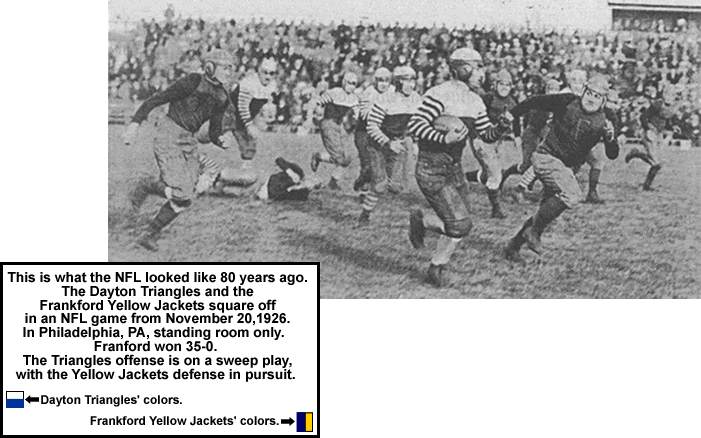Please note – I am posting this AAFC map and parts of my upcoming NFL, AFC North post here, so that there will be a stand-alone article on the AAFC in my archive. The NFL, AFC North post can be seen by clicking on the following link,
NFL, AFC North – Map, with short league-history side-bar & titles list (up to 2012 season) / Logo and helmet history of the 4 teams (Ravens, Bengals, Browns, Steelers).
-
Below: map of the AAFC, with selected AAFC uniforms and logos
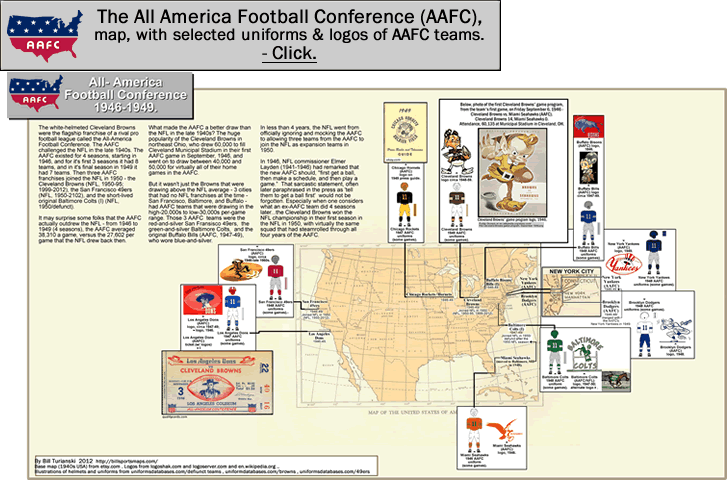
AAFC (1946-49) map
Image credits above – map of 1940s USA from etsy.com/listing/99272564/vintage-usa-map-1940s. Illustrations of AAFC uniforms from uniformdatabases.com/defunct teams, uniformdatabases.com/browns, uniformdatabases.com/49ers. Photo of LA Dons ticket from: qualitycards.com. Photo of 1949 AAFC Chicago Hornets media guide from ebay.com. Photo of 1946 Cleveland Browns game program from en.wikipedia.org/wiki/File:Cleveland_Browns_game_program,_September_1946.png. Logos of AAFC teams from logoserver.com/AAFC and logoshak.com [look in NFL section near bottom of 1st page there].
-
The Cleveland Browns, est. 1946 as a team in the rival league called the AAFC (1946-49)
The white-helmeted Cleveland Browns were the flagship franchise of a rival pro football league called the All-America Football Conference, which challenged the NFL in the late 1940s. The Browns origins date to 1944, when taxi-cab magnate Arthur ‘Mickey’ McBride secured the rights to a Cleveland franchise in the soon-to-be-formed All-America Football Conference. The AAFC existed for 4 seasons, starting in 1946, and for its first 3 seasons it had 8 teams, and in its final season in 1949 it had 7 teams.
The AAFC was the brainchild of Chicago Tribune sports editor Arch Ward. Several of the AAFC owners were actually better capitalized than some of the NFL owners at the time (back then, basically, NFL teams other than the Bears, the Giants and the Redskins were usually in poor financial shape). The AAFC challenged the NFL directly in the USA’s 3 biggest cities – in Los Angeles with the Los Angeles Dons, in Chicago with the Chicago Rockets, and in New York City with 2 teams…the New York Yankees (AAFC, 1946-49) and the Brooklyn Dodgers (AAFC, 1946-48).
AAFC Stadia -
The Cleveland Browns played at the 78,000-capacity Cleveland Municipal Stadium (and would play there until 1995). One of the teams in the AAFC played in the same stadium that their NFL city-rival were playing in – from 1946 to ’49, the Los Angeles Coliseum in Los Angeles, CA hosted both the Los Angeles Rams (NFL) and Los Angeles Dons (AAFC). The Brooklyn football Dodgers (AAFC) played at the Brooklyn baseball Dodgers’ Ebbets Field in Brooklyn, NY (note: the NFL’s Brooklyn football Dodgers played 15 seasons in the NFL but had folded two years before [in 1944]). The Chicago AAFC team, first called the Rockets then called the Hornets, played at Soldier Field (however, the NFL’s Chicago Bears played at Wrigley Field back then, and would not play in Soldier Field until 1971). The New York football Yankees of the AAFC played at Yankee Stadium (while the NFL’s New York Giants played at the Polo Grounds back then). The Buffalo Bisons, who changed their name to the Buffalo Bills (I) in the second AAFC season in 1947, played at the first version of War Memorial Stadium in Buffalo, which only had a capacity of 30,000 and did not yet have the giant looming roofed grandstand (which was built in 1960). The Baltimore Colts (I) of the AAFC played in Balltimore’s Municipal Stadium, which only had a single deck back then and a capacity of 30,000 (back in the 1946 to 1953 time period) [the second incarnation of the Baltimore Colts (II), also played at Baltimore's Memorial Stadium from 1953 to 1983]. The San Francisco 49ers of the AAFC played at Kezar Stadium, which was (and still is) a utilitarian-single-stand-with-bleachers-bowl-shape stadium with a 59,000-capacity that was built in a residential neighborhood of San Francisco which was adjacent to Golden Gate Park. The Forty-Niners played at Kezar Stadium from 1946-49 in the AAFC and from 1950 to 1970 in the NFL. The hapless and doomed Miami Seahawks played at the Orange Bowl to tiny crowds, then packed up and moved to Baltimore in ’47.
…
It may surprise some folks that the AAFC actually outdrew the NFL. From 1946 to 1949, the AAFC, averaged 38,310 a game, versus the 27,602 per game that the NFL drew back then {see this pdf, THE COFFIN CORNER: Vol. 2, No. 7 (1980). “ALL-AMERICA FOOTBALL CONFERENCE”, By Stan Grosshandler.
What made the AAFC a better draw than the NFL in the late 1940s? The huge popularity of the Cleveland Browns there in northeast Ohio, who drew 60,000 to fill Cleveland Municipal Stadium in their first AAFC game on September 6, 1946 (you can see the game program for that first Cleveland Browns game on the map page above), and went on to draw between 40,000 and 50,000 for most of their home games in the AAFC. {Here are the uniforms of the 1947 AAFC Cleveland Browns (gridiron-uniforms.com).} But it wasn’t just the Browns that were drawing above or near the NFL average – 3 other cities that had no NFL franchises at the time – San Francisco, Baltimore, and Buffalo – had AAFC teams that were drawing in the mid-20,000s-to-30,000s-per-game-range. Those 3 teams were the red-and-silver San Francisco 49ers {here are the uniforms of the 1948 AAFC San Francisco 49ers}, the green-and-silver-Baltimore Colts {here are the uniforms of the ‘1948 AAFC Baltimore Colts}; and the original Buffalo Bills (AAFC, 1947-49), who wore dark-blue-and-silver {here are the uniforms of the ‘1949 AAFC Buffalo Bills}. Of those 3, Baltimore had the smaller crowds (low 20K range), Buffalo played almost to capacity in their 30K-capacity stadium, and San Francisco drew the highest of the three, usually drawing above 30,000 and even getting 40,000 a few times. Another solid and very-good-drawing team in the AAFC was the New York football Yankees (AAFC, 1946-49), who lost to the Browns twice in the AAFC championship game – by score of 14-9 in 1946 in front of 41,000 at Cleveland’s Municipal Stadium, and in the following season (1947) the football Yankees lost again to the Browns in the title-game, by the score of 14-3 in front of an impressive 60,000 at Yankee Stadium. The AAFC Yankees, like their baseball namesakes, wore dark-navy-blue as their primary color, and added a secondary color of grey {here are the uniforms of the 1946 AAFC New York Yankees}. The Yankees of the AAFC probably would have been able to survive as an NFL team had the NFL allowed them to join in 1950, but the NFL chose not to let in any AAFC teams from cities which already had an NFL team or teams (ie, Los Angeles, Chicago and New York City).
The only problem with the AAFC, one that would prove to be its undoing, was the fact that the Cleveland Browns were too successful, and that, coupled with the fact that the AAFC had no draft, made all the other teams in the league unable to stay competitive with the Browns. A very telling statistic was this…the last 2 AAFC title games, both played in Cleveland, only drew 22,000, because everyone knew it was a foregone conclusion that the Browns would win those games (they won over the Bills 49-7 in front of 22,981 in 1948 and 21-7 over the 49ers in front of 22,550 in the last ever AAFC game in 1949 {see this, ‘AAFC/championship games‘ (en.wikipedia.org)}. Another problem was the weakness of the last 2 AAFC franchises to form – the Brooklyn team and the Miami franchise (which moved to Baltimore after losing $350,000 as the Miami Seahawks in 1946). The Brooklyn team closed up after the third AAFC season (1948) and merged with the Yankees AAFC team for the league’s last season in 1949 (they were officially called the Brooklyn-New York Yankees, but no one called them that). The Miami-to-Baltimore franchise was always under-capitalized, while the green-and-silver original Baltimore Colts (I) were never able to muster the large support that the second (blue-and-white) Baltimore Colts (II) had. The Baltimore Colts of the AAFC were the weakest of the 3 teams that the NFL allowed to join in 1950 and only lasted one season. As it says in the AAFC page at en.wikipedia.org, …{excerpt}…”There was some sentiment to admit the Bills rather than the Colts, as the Bills had better attendance and the better team. However, Buffalo’s size (only Green Bay was smaller) and climate were seen as problems”…{end of excerpt}. The NFL chose the Colts (I) instead of the Bills (I) as an expansion team in 1950, and the city of Buffalo would have to wait another 20 years before they got a modern-day NFL franchise.
Three AAFC franchises joined the NFL in 1950 – the Cleveland Browns (NFL, 1950-95; 1999-2012), the San Francisco 49ers (NFL, 1950-2102), and the short-lived original Baltimore Colts (I) (NFL, 1950/defunct).
In less than 4 years, the NFL went from officially ignoring and publicly mocking the AAFC to allowing three teams from the AAFC to join the NFL in 1950. In 1946, NFL commissioner Elmer Layden had remarked that the new AAFC should, “first get a ball, then make a schedule, and then play a game.” That sarcastic statement, often later paraphrased in the media as “tell them to get a ball first”, would not be forgotten. Especially when you consider what an ex-AAFC team did 4 seasons later…the Cleveland Browns won the NFL championship in their first season in the NFL in 1950, with virtually the same squad that had steamrolled through all four years of the AAFC.
…
-
The Cleveland Browns – from AAFC champions to NFL champions in 1950, as an expansion team.
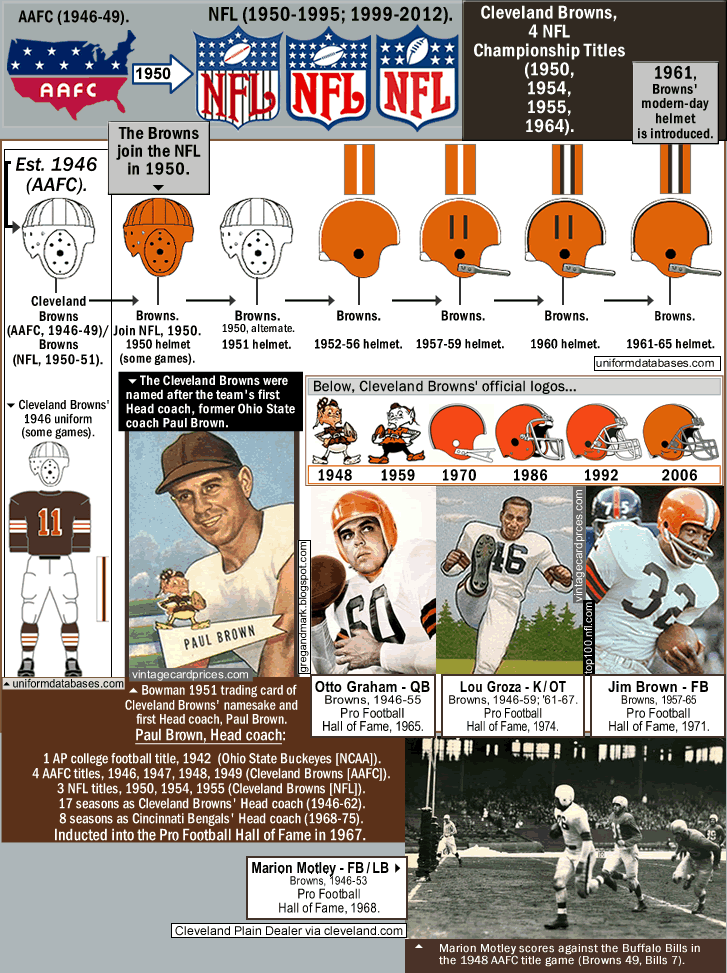
Image and Photo credits above -
Helmet and uniform illustrations from uniformdatabases.com/browns.
Photo of 1951 Bowman Paul Brown trading card from vintagecardprices.com.
Tinted b&w photo of Otto Graham unattributed at gregandmark.blogspot.com/2009/12/otto-graham-episode.
Photo of 1950 Bowman trading card of Lou Groza at vintagecardprices.com.
Photo of Jim Brown from top100.nfl.com/all-time-100.
Photo of Marion Motley in 1948 AAFC championship game from Cleveland Plain Dealer archive via cleveland.com.
The Cleveland Browns were founded in the 1946 as a charter franchise of the All-America Football Conference (AAFC), with Paul Brown, the team’s namesake and a pioneering figure in professional football, as its first head coach and General Manager. Paul Brown first made his name as a 34-year-old head coach who led the Ohio State Buckeyes to the school’s first national football championship (in 1942, as the AP #1). During World War II, Paul Brown served in the U.S. Navy near Chicago as a coach and instructor at the Great Lakes Naval Station, where he coached the football team. Later, in 1945-46, when he formed his first Cleveland Browns team, Brown utilized the contacts he had made within both the college football world and within the military. For example, during his time in the Navy there at the Naval Station near Chicago, Paul Brown first met his future Cleveland Browns’ quarterback Otto Graham, who was attending Northwestern University and who became a Navy flier. Brown then signed Graham in April 1945 plucking a future-gridiron-star before any NFL team could ever draft him. Many of the Cleveland Browns players in 1946 were military veterans. With standout players such as Otto Graham (at QB, running a then-innovative T-formation offense), pioneering player Marion Motley (a running back and linebacker and one of the first black players in pro football in the modern era), and northeast-Ohio-born Lou Groza (who doubled as the team’s placekicker and as an offensive tackle), the Cleveland Browns won all 4 AAFC championships.
From ‘Paul Brown‘ (en.wikipedia.org),
{excerpt}…”Brown is credited with a number of American football innovations. He was the first coach to use game film to scout opponents, hire a full-time staff of assistants, and test players on their knowledge of a playbook. He invented the modern face mask, the taxi squad and the draw play. He also played a role in breaking professional football’s color barrier, bringing some of the first African-Americans to play pro football in the modern era onto his teams.”…{end of excerpt}.
Under Paul Brown, not only did the Cleveland Browns win all 4 of the the AAFC’s championships, the Browns also drew huge crowds, averaging a record-setting 57,000 per game in the first season of the AAFC in 1946. Cleveland Browns’ crowds were often above 50,000, and the Browns averaged a much, much higher gate than the NFL of the late 1940s. The Browns continued to succeed after moving to the NFL in 1950. Cleveland won the NFL championship in its first NFL season, and won two more titles in 1954 and 1955. By then, the Browns had appeared in 10 straight championship games (4 in the AAFC, then 6 in the NFL), and won 7 of them.
-
Enter Art Modell, exit Paul Brown, and the start of Cleveland Browns fans’ trials and tribulations…
Then Art Modell, who made his money in the New York City advertising industry, bought the team in 1961, fired Paul Brown two years later, and reigned over a team that won just 1 more NFL championship title but never made a Super Bowl appearance, then announced he intended to moved the team to Baltimore in 1996 despite the fact that the city of Cleveland was about to vote on a new stadium referendum (which passed). Art Modell never set foot in Cleveland again after he took the Browns’ front office and the Browns’ player roster to Baltimore, to become the Baltimore Ravens (NFL, 1996-2012). Cleveland Browns supporters raised such an outcry that the NFL was forced to make the unprecedented move of forcing Modell to return the Cleveland Browns’ records, history, colors, and uniform design back to Cleveland to await the re-birth of the Cleveland Browns’ franchise. That occurred in 1999. The only problem was – Modell took that 1995 Cleveland Browns team and turned it into the 2000 Baltimore Ravens Super Bowl champions. So Browns fans might have got their team back, but they will always wonder what might have been if the ’95 Browns had remained in Cleveland.
___
Thanks to Logoshak for many of the AAFC logos.
Thanks to logosever.com for several AAFC logos.
Thanks to the contributors to the pages at en.wikipedia.org, ‘All-America Football Conference‘.
Thanks to Chris Creamer’s Sports Logos Page at sportslogos.net, for some logos and for dates of logos.
Thanks to The Gridiron Uniform Database for allowing billsportsmaps the use of the site’s helmet and uniform illustrations,
uniformdatabases.com/defunct teams [APFA, NFL, AAFC), uniformdatabases.com/browns,
uniformdatabases.com/49ers.
